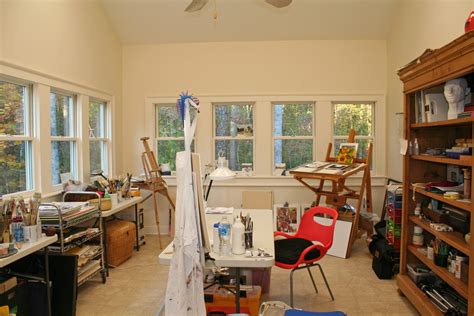Introduction

An art studio is more than just a workspace; it’s a sanctuary where creativity flourishes. Designing your studio to meet your specific needs and aspirations is essential for maximizing productivity and inspiration. This comprehensive guide will provide you with expert insights, practical tips, and innovative ideas to help you craft an art studio that empowers your artistic journey.
Understanding Your Needs
Before embarking on the design process, it’s crucial to evaluate your artistic needs and preferences. Consider the following:
- Type of art: Different art forms, such as painting, sculpture, or photography, require specialized equipment and a tailored environment.
- Workspace size: Determine the minimum amount of space required for your current and future artistic endeavors.
- Equipment storage: Ample and organized storage for canvases, tools, and materials is essential.
- Lighting: Natural and artificial lighting play a significant role in creating the optimal ambiance for your artwork.
- Ventilation: Proper ventilation ensures a safe and healthy workspace, especially when working with materials that may release fumes.
- Budget: Set a realistic budget that aligns with your design goals and financial capabilities.
Layout and Space Planning
The layout of your studio should optimize workflow, minimize distractions, and inspire creativity. Key considerations include:
- Workstation positioning: Position your work surface strategically to maximize natural light, provide ample space, and reduce glare.
- Flow of movement: Create a seamless flow between storage areas, work surfaces, and display zones.
- Focal point: Designate a focal point, such as a large window or an inspirational piece of art, to draw attention and create a sense of purpose.
- Vertical space utilization: Utilize wall-mounted shelves, pegboards, or art racks to maximize storage capacity.
- Multi-functional areas: Consider incorporating multi-functional areas, such as a convertible storage-display unit, to enhance space efficiency.
Lighting and Ambiance
Lighting is a critical factor that impacts both your creativity and the accuracy of your artwork. Carefully consider:
- Natural light: Take advantage of natural light through large windows or skylights. Adjust blinds or curtains to control the intensity.
- Artificial light: Supplement natural light with artificial sources, such as LED panels or adjustable track lighting.
- Color temperature: Choose light bulbs with a color temperature that complements your artwork and creates the desired ambiance.
- Dimmers and switches: Add dimmers or multiple switches to adjust lighting levels based on the task at hand.
- Ambiance: Create a cozy and inspiring atmosphere with warm colors, dim lighting, and ambient music.
Equipment and Storage
The right equipment and storage solutions can make or break your art studio. Invest in:
- Essential tools: Identify and acquire the essential tools and materials for your art form, considering quality and durability.
- Custom storage: Design custom storage solutions that cater to your specific equipment and materials.
- Organization: Implement organizational systems, such as drawer dividers or wall-mounted racks, to keep everything in its place.
- Maintenance and cleaning: Establish a regular cleaning and maintenance routine to keep your tools and equipment in optimal condition.
- Ergonomics: Consider ergonomic tools and equipment to minimize strain and discomfort while working.
Inspiration and Motivation
Your art studio should be a place that inspires and motivates you to create your best work. Incorporate elements that:
- Display artwork: Display your own artwork or inspiring pieces from others to ignite your imagination.
- Add personal touches: Personalize your studio with meaningful objects, such as plants, photographs, or artwork that connects you to your passion.
- Set goals and aspirations: Set up a dedicated space for vision boards or project planning to keep your artistic goals top of mind.
- Create a breakout area: Include a designated breakout area where you can relax, recharge, and gather inspiration.
- Collaborate with others: Consider sharing your studio space with fellow artists to foster creativity and exchange ideas.
Tips and Tricks
- Embrace technology: Utilize software and digital tools to streamline your workflow and enhance creativity.
- Seek professional advice: Consult with architects or interior designers specialized in art studio design for expert guidance.
- Consider multi-use furniture: Choose furniture that can serve multiple purposes, such as storage ottomans or adjustable desks.
- Experiment with virtual reality: Explore virtual reality technology to create immersive experiences and expand your artistic possibilities.
- Utilize natural elements: Incorporate natural elements, such as plants or water features, to create a calming and inspiring environment.
Useful Tables
| Table 1: Average Square Footage Requirements for Art Studios |
|—|—|—|
| Art Form | Minimum Square Footage | Ideal Square Footage |
| Painting | 150 – 250 | 400 – 600 |
| Sculpture | 250 – 500 | 600 – 1000 |
| Photography | 100 – 150 | 200 – 300 |
| Mixed Media | 200 – 300 | 500 – 800 |
| Table 2: Recommended Lighting Levels for Art Studios |
|—|—|—|
| Task | Lumens | Color Temperature (K) |
| Painting | 500 – 1000 | 5000 – 6500 |
| Drawing | 250 – 500 | 4500 – 5500 |
| Photography | 1000 – 2000 | 5500 – 6500 |
| Mixed Media | 750 – 1500 | 4700 – 5500 |
| Table 3: Essential Tools for Different Art Forms |
|—|—|—|
| Art Form | Essential Tools |
| Painting | Brushes, canvases, paint, palette |
| Sculpture | Chisels, hammers, carving tools, clay |
| Photography | Camera, tripod, lenses, editing software |
| Mixed Media | Collage materials, scissors, adhesives, various tools |
| Table 4: Innovative Storage Solutions for Art Studios |
|—|—|—|
| Storage Type | Solution | Benefits |
| Wall-mounted | Pegboards, shelves | Maximizes vertical space, easy access |
| Modular | Stackable bins, drawer units | Customizable to fit specific storage needs |
| Multi-functional | Convertible storage-display units | Saves space, provides both storage and display options |
| Rolling | Storage carts, tool chests | Provides mobility, easy access to tools and materials |
